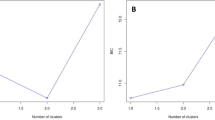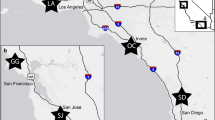Abstract
Understanding the genetic connectivity among populations of spreading and problematic species is important to determine the spatial scale at which management actions need to be conducted. The feral pigeon (Columba livia) is considered to be a pest or an invasive species in many cities around the world, leading to frequent attempts to control its populations. In the present study, we used microsatellites markers to investigate the relationship between genetic structure and geographic distance among feral pigeons from different locations, and the patterns of genetic differentiation at two geographic scales, within and between urbanised areas. A Mantel’s test revealed that the levels of genetic differentiation increased significantly with the geographic distance separating the locations. We also found that neighbouring locations within urban areas are usually not genetically differentiated, suggesting that all of the feral pigeons in an urban zone constitute a single management unit. Our results suggest that in large, interconnected cities control by culling at the scale of a neighbourhood, in addition of generating ethical issues, will not be effective to decrease pigeon population sizes.

Similar content being viewed by others
References
Excoffier L, Laval G, Schneider S (2005) Arlequin 3.0: an integrated software package for population genetics data analysis. Evol Bioinform Online 1:47–50
Giunchi D, Albores-Barajas Y, Baldaccini N, Vanni L, Soldatini C (2012) Feral pigeons: problems, dynamics and control methods. In: Soloneski S (ed) Integrated pest management and pest control—current and future tactics. InTech, pp 215–240. doi:10.5772/31536
Goudet J (2001) FSTAT, a program to estimate and test gene diversities and fixation indices. Institute of Ecology and Evolution, University of Lausanne, Lausanne, Switzerland. http://www2.unil.ch/popgen/softwares/fstat.htm
Guo SW, Thompson EA (1992) Performing the exact test of Hardy-Weinberg proportion for multiple alleles. Biometrics 48:361–372
Haag D (1991) Population density as a regulator of mortality among eggs and nestlings of feral pigeons (Columba livia domestica) in Basel, Switzerland. In: Pinowski J, Kavanagh BP, Górski W (eds) Nestling mortality of granivorous birds due to microorganisms and toxic substances. Polish Scientific Publishers, Warsaw, pp 21–31
Haag-Wackernagel D (1993) Street pigeons in basel. Nature 361:200
Haag-Wackernagel D (2002) Feral pigeons: management experiences in Europe. In: Atti 2° Convegno Nazionale sulla Fauna Urbana “Specie ornitiche problematiche: biologia e gestiona nelle città e nel territorio”, pp 25–37, Firenze, 10 giugno 2000, ARSIA e LIPU. Regiona Toscana, Firenze
Hardy OJ, Vekemans X (2002) SPAGEDi: a versatile computer program to analyse spatial genetic structure at the individual or population levels. Mol Ecol Notes 2:618–620
Hardy OJ, Charbonnel N, Freville H, Heuertz M (2003) Microsatellite allele sizes: a simple test to assess their significance on genetic differentiation. Genetics 163:1467–1482
Hetmanski T (2007) Dispersion asymmetry within a feral pigeon Columba livia population. Acta Ornithol 42:23–31
Hetmanski T, Barkowska M (2007) Density and age of breeding pairs influence feral pigeon, Columba livia, reproduction. Folia Zool 56:71–83
Jerolmack C (2008) How pigeons became rats: the cultural-spatial logic of problem animals. Soc Probl 55:72–94
Johnston RF, Janiga M (1995) Feral pigeon. Oxford University Press, New York
Kautz JE, Malecki RA (1990) Effects of harvest on feral rock dove survival, nest success and population size. Fish and wildlife technical report (USA). No. 31
Morand-Ferron J, Lalande E, Giraldeau LA (2009) Large-scale input matching by urban feral pigeons (Columba livia). Ethology 115:707–712
Palsbøll PJ, Berube M, Allendorf FW (2007) Identification of management units using population genetic data. Trends Ecol Evol 22:11–16
Peakall R, Smouse PE (2006) GenAlEx 6: genetic Analysis in Excel. Population genetic software for teaching and research. Mol Ecol Notes 6:288–295
Petit RJ, El Mousadik A, Pons O (1998) Identifying populations for conservation on the basis of genetic markers. Conserv Biol 12:844–855
Robertson BC, Gemmell NJ (2004) Defining eradication units to control invasive pests. J Appl Ecol 41:1042–1048
Rollins LA, Woolnough AP, Sherwin WB (2006) Population genetic tools for pest management: a review. Wildl Res 33:251–261
Skandrani Z, Lepetz S, Prévot-Julliard A-C (2014) Nuisance species: beyond the ecological perspective. Ecological Process 3:3
Slatkin M (1993) Isolation by distance in equilibrium and non-equilibrium populations. Evolution 47:264–279
Sol D, Senar JC (1992) Comparison between two censuses of Feral Pigeon Columba livia var. from Barcelona: an evaluation of seven years of control by killing. Butlleti del Grup Catala d’Anellament 9:29–32
Sol D, Senar JC (1995) Urban pigeon population: stability, home range, and the effect of removing individuals. Can J Zool 73:1154–1160
Sol D, Santos DM, Cuadrado M (2000) Age-related feeding site selection in urban pigeons (Columba livia): experimental evidence of the competition hypothesis. Can J Zool 78:144–149
Stringham SA, Mulroy EE, Xing J, Record D, Guernsey MW, Aldenhoven JT, Osborne EJ, Shapiro MD (2012) Divergence, convergence, and the ancestry of feral populations in the domestic rock pigeon. Curr Biol 22:302–308
Traxler B, Brem G, Muller M, Achmann R (2000) Polymorphic DNA microsatellites in the domestic pigeon Columba livia var. domestica. Mol Ecol 9:366–368
Acknowledgments
The authors would like to thank Daniel Simberloff and two anonymous reviewers for their valuable comments on a previous version of this paper. This study is part of a larger research program on urban pigeons supported by grants from the ANRJC (ANR-05-JCJC-0098-01), the Region Ile-de-France (no. 06-1064 MN 07) and the Seine-Saint-Denis department.
Author information
Authors and Affiliations
Corresponding author
Rights and permissions
About this article
Cite this article
Jacob, G., Prévot-Julliard, AC. & Baudry, E. The geographic scale of genetic differentiation in the feral pigeon (Columba livia): implications for management. Biol Invasions 17, 23–29 (2015). https://doi.org/10.1007/s10530-014-0713-2
Received:
Accepted:
Published:
Issue Date:
DOI: https://doi.org/10.1007/s10530-014-0713-2




